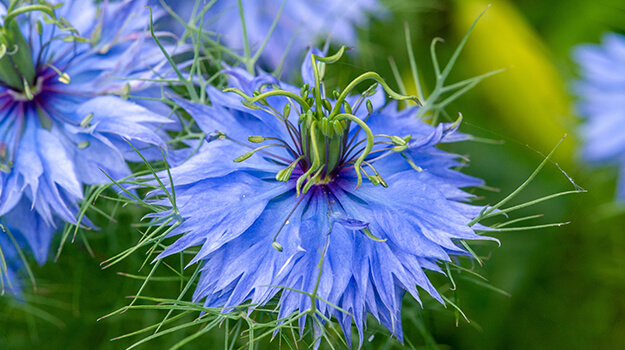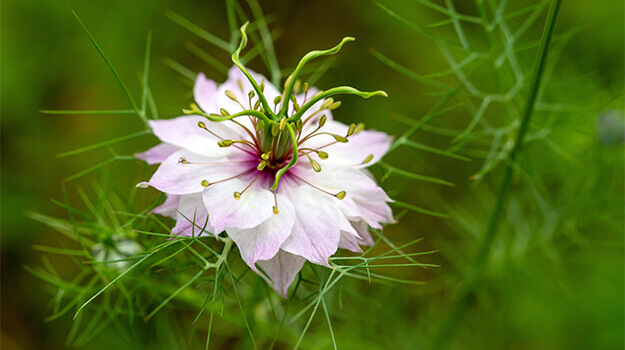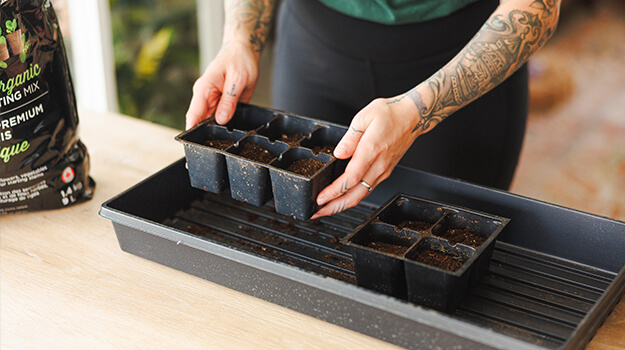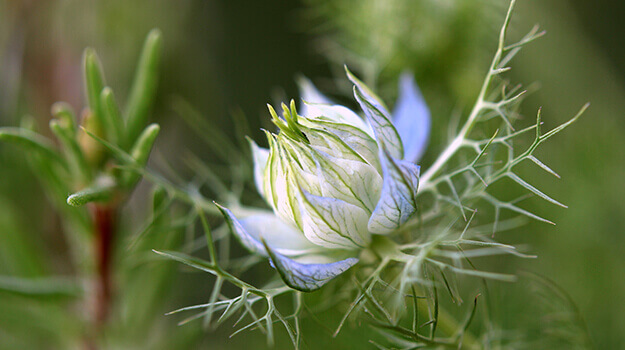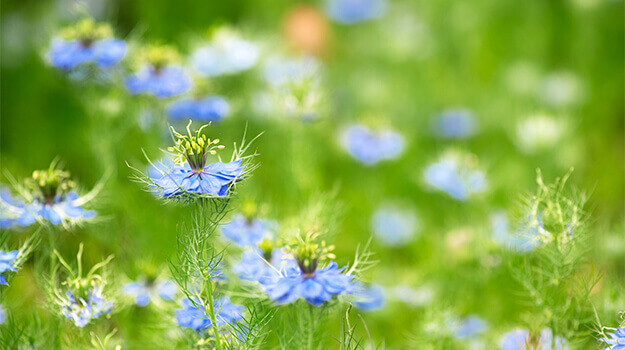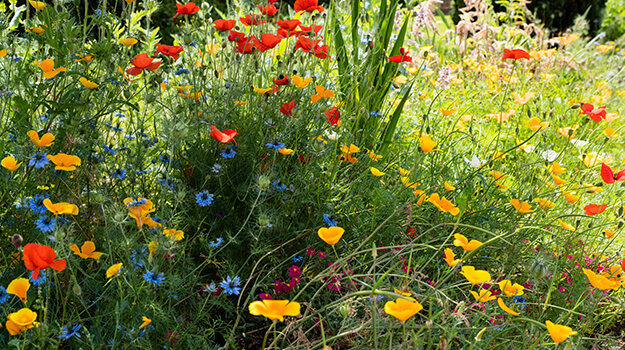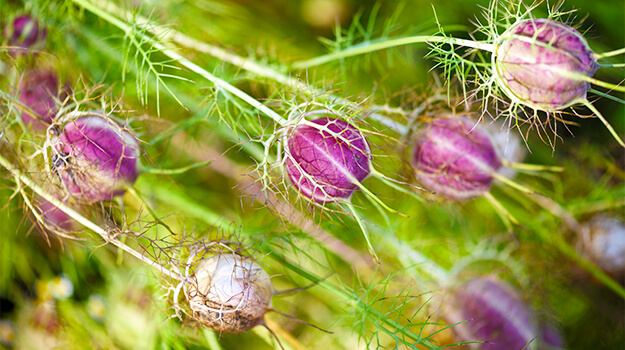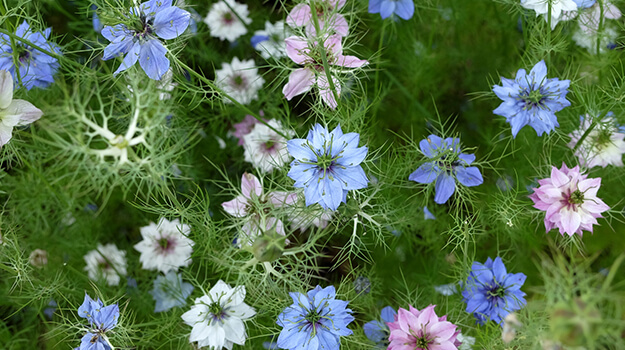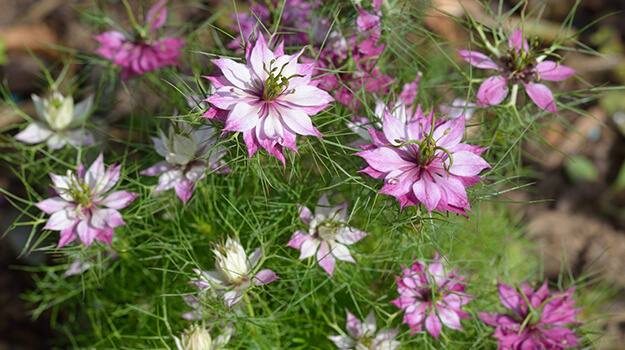- Nigella damascena Love-in-a-Mist
- How to sow annuals indoors
- How to transplant or sow directly in the garden
- How to propagate Nigella
- Growing tips for Nigella
- Use in the garden
- Suggested associations
- Cut flower bouquets and dried flower arrangements
- Which Nigella to choose to have beautiful flowers?
- Fact sheet on Nigella
Many people sow vegetables and aromatic herbs, but few sow their flowers indoors. However, there are many advantages to this, such as having access to flowers as exceptional as Nigella damascena Love-in-a-Mist.
Very easy to sow and cultivate, it grows almost anywhere and requires little maintenance. Better still, in many regions, it reseeds itself in the garden, without ever overtaking the space.
These are qualities that deserve to be cultivated!
Nigella damascena Love-in-a-Mist
Capable of coping with climate change, this beautiful annual is practically disease and insect-free, invariably offering its spectacle in three stages.
First, its foliage develops as a fine lace, becoming more and more jagged as it rises towards the sky, until it becomes completely fringed. It is its feathery appearance that has earned the Nigella damascena its many nicknames: Venus's hair, love-in-a-mist, devil-in-the-bush, etc.
Secondly, the flowers come in a star shape with a diameter of 2 to 5 cm. The colour is often blue, but also pink, white or purple, sometimes almost red, and the flowers emerge at the top of the stems. Delicate, airy and carefully designed, they are set with a collar with semi-double, double or even triple petals. In the centre of the flower, 5 to 10 erect pistils are surrounded by many contrasting stamens, adding to the elegance of the flower.
Finally, later on, the seed pods appear and are almost as decorative as the flowers. Their large, swollen purple and violet pods are surrounded by dried, threadlike bracts standing on top. Left on the plant, you would almost believe that you are witnessing the flowering of a completely different plant species. Collected, they make up exceptional dried bouquets.
How to sow annuals indoors
Nigella is easy to sow. For the best germination and assurance that the seedlings have all the nutrients necessary for their proper development, select a soil specially developed for this purpose, such as PRO-MIX Organic Seed Starting Mix.
For early flowering, sow indoors 4 to 6 weeks before the last frost date. In most regions, Nigella can be sown from March to May. Plant the seeds at a depth equivalent to 3 times their size and water with a spray bottle. Keep the soil mix moist until the seedlings appear.
PRO TIP: Successive sowing will allow you to enjoy the flowering over a longer period!
How to transplant or sow directly in the garden
The seedlings can be transplanted to the garden once the soil has warmed, and all risk of frost has passed. Choose the location carefully to avoid moving the plants later. The fragile roots of Nigella do not appreciate being disturbed.
At the same time, the seeds can also be sown outdoors. Prepare the soil by removing stones and weeds and breaking up clods of soil. Then level it by adding a thin layer of quality potting soil like our PRO-MIX Organic Vegetable & Herb Mix.
For a natural look, broadcast the seeds loosely on the garden bed and then cover them with a thin layer of potting soil. Lightly compress and keep the soil moist until germination. Once the seeds have germinated, thin them out so that there is a space of 20 cm between plants.
PRO TIP: In regions with mild winters, you can get early flowering by sowing Nigella in the ground in the fall.
Sowing calendar - Nigella
- Crop cycle: Annual
- Suggested sowing*: Outdoors (May) or indoors (April)
- Ideal germination temperature: 15 to 21 ℃
- Germination time: 7 to 14 days
- Sowing depth: Three times the size of the seed
- Seed storage: In a cool, dry place away from light
- Seed storage time: 2 years
- Exposure: Sun or light shade
- Number of days to maturity: 75 days
- Planting distance: 20 cm
*In zone 4b.
How to propagate Nigella
In temperate regions, once introduced into the garden, Nigella reseeds itself easily (its seeds are frost-resistant when the winter is mild). It is not invasive and only fills gaps in flower beds.
In colder regions, it is easy to reproduce Nigella by saving seeds. The seeds are ready to harvest when the pods turn brown and begin to open.
The seeds will keep for up to two years in the dark in a cool, dry place.
NOTE: As the seeds are sown, the flowers may change colour slightly. To return to the original variety, it is necessary to buy new seeds.
Growing tips for Nigella
Nigella is one of the easiest plants to grow, requiring no special maintenance, other than occasional weeding and watering.
During the summer, it flowers from June to August, sometimes until September. Its flowering will be early or later depending on the date on which the seeds were sown. Each flower is short-lived but is quickly replaced by a pod that is almost as decorative.
This annual plant, 20 to 40 cm tall, grows almost anywhere and is happy with poor, dry, rocky or sandy soil, in the sun or partial shade. It is therefore an excellent choice for brightening up a corner of the garden that is difficult to flower.
Although it is not very demanding, it can reach a height of 60 cm in richer soil. It is therefore advantageous to grow it in quality potting soil that is rich in organic matter and drains well, where water can easily get into.
Use in the garden
Spectacular throughout the season, Nigella works wonders in the foreground as a clump with taller plants in the background.
Misty-looking but rather abundant, its foliage creates a dense mass to fill empty spaces in flower beds, embankments and rock gardens. Since it is reliable, it grows well in hard-to-reach areas and at the foot of rose bushes and shrubs.
It can also be grown in a pot or planter in a substrate that retains water well to reduce watering needs, such as our PRO-MIX Potting Mix.
Suggested garden associations
Here are some suggestions for plants that Nigella goes wonderfully with.
- Perennials in shades of blue: cornflower (wild cornflower), perennial flax
- Annuals: cosmos and marigolds
- Red or orange flowers: oriental poppies, asiatic lilies, marigolds, poppies
- Plants for English gardens: astrantia (masterwort), baby's breath, phlox
- Grasses
- Shrub roses
- Plants for dry and rocky soil: lavender, yarrow
- Flowers in dark shades: Midnight Blue delphiniums, Black Barlow columbine, Black Knight butterfly bush
Cut flower bouquets and dried flower arrangements
The fresh flowers of Nigella are beautiful in cut flower bouquets, but it doesn't stop there.
Its colourful and very decorative seed pods also find their place in dried arrangements. The flowers are dried upside down before the pods are fully opened. Its fruit is of good size, round and nicely coloured, decorative and durable.
Which Nigella to choose to have beautiful flowers?
Here are some flowering varieties to grow:
- Nigella Love-in-a-Mist, blue flowers that produce large mauve pods
- Nigella Blue Midget, blue flowers
- Nigella Miss Jeckyll, sky blue flowers
- Nigella Mulberry, double purple-pink flowers
- Nigella Persian Rose, pink flowers
- Nigella Orientalis, stands out for its yellow flowering! There are also seed mixes that give an assortment of flowers in various colours.
- Nigella Dwarf Moody Blue, purple-mauve flowers that turn blue
Fact sheet on Nigella
Originally from Syria, Nigella is part of the buttercup family, which includes more than 2,000 species of plants, mainly herbaceous and often toxic, such as hellebore, aconite, columbine, clematis, delphinium and anemone.
- Flowering period: Between June and August, sometimes until September
- Height: 20 to 60 cm
- Width: 20 to 25 cm
- Exposure: Sun or partial shade
- Soil type: Light and well-drained with a neutral pH. Tolerates poor and rocky soils.
WARNING! The seeds of cultivated Nigella (Nigellus sativus) are prized in cooking for their wild strawberry aroma and are available in some delicatessens. Those of Nigella damascena are toxic and represent a danger when consumed.

